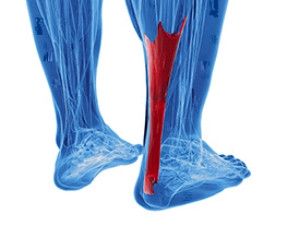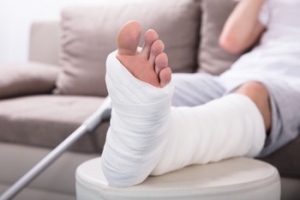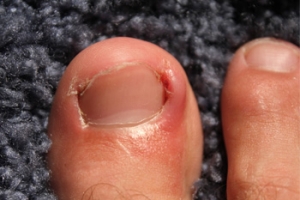
Foot and Ankle Trauma
Broken Feet
A broken foot can either refer to a fracture or a straight break. The location of any break can tell you how the break happened. Toes, for instance, break typically as a result of something being kicked hard and with great force. Heel breaks almost always are a result of an improper landing from a tall height. Twists or sprains are the other two frequent occurrences. As with all usual breaks, they result from unexpected accident or sudden injury. As with stress fractures, breaks form as a process over time from repeated stress on already present cracks. Runners, dancers, and gymnasts are the usual athletes who receive this type of break. Stress fractures result from incredible pressure on the feet. It is no surprise these athletes bear the majority of reported fractures.
Pain, swelling, bruising, and redness are all indicative of the typical symptoms from a broken foot. Severe pain—to the point of not being able to walk—usually depends on the location of the break in the foot. Toes are on the lower scale of pain threshold, but heels are high, as are a few other particular bones. As the severity of the broken foot increases, symptoms like blueness, numbness, misshaping of the foot, cuts, or deformities will become apparent. These symptoms indicate the need to see a medical professional with access to an x-ray facility.
Prior to seeing a specialist, precautions should be taken to reduce pain and swelling. Elevate and stabilize the foot, and refrain from moving it. Immobilization of the foot is the next priority, so creating a homemade splint is acceptable. Keep in mind that while creating a splint, any increase of pain or cutting off blood circulation means that the splint should be removed immediately. Use ice to decrease swelling and relieve pain symptoms.
When dealing with a medical center, the patient should note that the treatment can vary. The treatment will depend on the severity of the fracture and the cause of the break. Crutches, splits, or casts are common treatments while surgery has been known to be used in more severe cases in order to repair the break in the bones.
Broken Ankles
Broken ankles are a serious injury that can lead to an inability to walk, function, and also cause a significant amount of pain. A broken ankle is a break in one of the three bones in your body that connect at the ankle joint, the tibia, the fibula, and the talus. The tibia and fibula are your two primary leg bones that connect at the knee, which sits directly upon the talus bone. This is protected by a fibrous membrane that allows for movement in our ankle joint. A broken ankle is usually caused by the foot rolling under or twisting too far, causing one of these three bones to snap.
A broken ankle is different from an ankle sprain, which occurs when the ligaments are ripped or torn but no bones have been broken. A sprain can still be very severe, causing bruising in the foot and an inability to hold your own weight, much like a broken ankle would. If you’re unable to stand, and suspect that you have a broken ankle, the first thing to do would be to get an immediate x-ray to determine the severity of the break.
A common cause of broken ankles is when the ankle is rolled over with enough pressure to break the bones. This usually happens during exercise, sports, or other physical activities. Another common cause is a fall or jump from a tall height.
One immediate treatment for pain relief is elevating the feet above your head to reduce blood flow to the injured area. You can also apply ice packs to your ankles to help reduce swelling, redness, inflammation, and pain. After these initial steps, getting a cast and staying off your feet as much as possible will aid in the recovery of the broken ankle. The less movement and stress the ankle has to endure, the more complete it will heal. A doctor can determine if surgery is needed in order to heal correctly. In these cases, an operation may be the only option to ensure the ability to walk properly again, followed by physical therapy and rehabilitation.
It is highly important to determine if surgery is needed early on, because a broken ankle can become much more severe than you realize. If not professionally treated, the broken ankle will inhibit your walking, daily functioning, and produce a large amount of pain. Treating your broken ankle early on will help prevent further damage to it.
Possible Causes of Injuries That Affect the Achilles Tendon
 The location of the Achilles tendon is in the back of the leg and its function is to connect the heel bone to the calf muscle. If an injury should occur to this tendon, noticeable symptoms may include severe pain, difficulty in walking, or your ankles may feel weak. Many patients are unable to fully stand on the leg and swelling or bruising may be apparent. There are several causes as to why the Achilles tendon may rupture, and these may include falling unexpectedly, pivoting suddenly while participating in running or jumping activities, or ingesting specific types of medication, which may increase the chances of injuring this tendon. Research has shown if the calf muscles are gently stretched before sporting activity begins, the Achilles tendon may lengthen and become more flexible. If you feel you have injured this specific tendon, it is advised to seek the counsel of a podiatrist who can offer proper treatment advice.
The location of the Achilles tendon is in the back of the leg and its function is to connect the heel bone to the calf muscle. If an injury should occur to this tendon, noticeable symptoms may include severe pain, difficulty in walking, or your ankles may feel weak. Many patients are unable to fully stand on the leg and swelling or bruising may be apparent. There are several causes as to why the Achilles tendon may rupture, and these may include falling unexpectedly, pivoting suddenly while participating in running or jumping activities, or ingesting specific types of medication, which may increase the chances of injuring this tendon. Research has shown if the calf muscles are gently stretched before sporting activity begins, the Achilles tendon may lengthen and become more flexible. If you feel you have injured this specific tendon, it is advised to seek the counsel of a podiatrist who can offer proper treatment advice.
Achilles tendon injuries need immediate attention to avoid future complications. If you have any concerns, contact Dr. Lee R. Stein of Lake Shore Foot & Ankle, PC. Our doctor can provide the care you need to keep you pain-free and on your feet.
What Is the Achilles Tendon?
The Achilles tendon is a tendon that connects the lower leg muscles and calf to the heel of the foot. It is the strongest tendon in the human body and is essential for making movement possible. Because this tendon is such an integral part of the body, any injuries to it can create immense difficulties and should immediately be presented to a doctor.
What Are the Symptoms of an Achilles Tendon Injury?
There are various types of injuries that can affect the Achilles tendon. The two most common injuries are Achilles tendinitis and ruptures of the tendon.
Achilles Tendinitis Symptoms
- Inflammation
- Dull to severe pain
- Increased blood flow to the tendon
- Thickening of the tendon
Rupture Symptoms
- Extreme pain and swelling in the foot
- Total immobility
Treatment and Prevention
Achilles tendon injuries are diagnosed by a thorough physical evaluation, which can include an MRI. Treatment involves rest, physical therapy, and in some cases, surgery. However, various preventative measures can be taken to avoid these injuries, such as:
- Thorough stretching of the tendon before and after exercise
- Strengthening exercises like calf raises, squats, leg curls, leg extensions, leg raises, lunges, and leg presses
If you have any questions please feel free to contact one of our offices located in Chicago, Highland Park, and Uptown, IL . We offer the newest diagnostic tools and technology to treat your foot and ankle needs.
What are Achilles Tendon Injuries
The Achilles tendon is the strongest tendon in the human body. Its purpose is to connect the lower leg muscles and calf to the heel of the foot. This tendon is responsible for facilitating all types of movement, like walking and running. This tendon provides an enormous amount of mobility for the body. Any injuries inflicted to this tissue should be immediately brought up with a physician to prevent further damage.
The most common injuries that can trouble the Achilles tendon are tendon ruptures and Achilles tendinitis. Achilles tendinitis is the milder of the two injuries. It can be recognized by the following symptoms: inflammation, dull-to-severe pain, increased blood flow to the tendon, thickening of the tendon, and slower movement time. Tendinitis can be treated via several methods and is often diagnosed by an MRI.
An Achilles tendon rupture is trickier to heal, and is by far the most painful injury. It is caused by the tendon ripping or completely snapping. The results are immediate and absolutely devastating, and will render the patient immobile. If a rupture or tear occurs, operative and non-operative methods are available. Once the treatment begins, depending on the severity of the injury, recovery time for these types of issues can take up to a year.
Simple preventative measures can be taken as a means to avoid both injuries. Prior to any movement, taking a few minutes to stretch out the tendon is a great way to stimulate the tissue. Calf raises, squats, leg curls, leg extensions, leg raises, lunges, and leg presses are all suggested ways to help strengthen the lower legs and promote Achilles tendon health.
Many problems arise among athletes and people who overexert themselves while exercising. Problems can also happen among those who do not warm up properly before beginning an activity. Proper, comfortable shoes that fit correctly can also decrease tendon injuries. Some professionals also suggest that when exercising, you should make sure that the floor you are on is cushioned or has a mat. This will relieve pressure on the heels. A healthy diet will also increase tendon health.
It is very important to seek out a podiatrist if you believe you have an injury in the Achilles region. Further damage could result in severe complications that would make being mobile difficult, if not impossible.
Symptoms of a Broken Foot
 Research has shown that one out of ten broken bones happens in the foot. If tripping, falling, or dropping a heavy object on your foot occurs, you may experience a painful condition known as a broken foot. You will immediately notice symptoms that may include severe pain and swelling, possibly hindering the ability to walk, and bruising or tenderness. Additionally, the toes may be deformed if the bones appear to be dislocated. If you have fallen and you think your foot may be fractured, a proper diagnosis must be performed that will confirm the broken foot. This is typically accomplished by having an X-ray taken, followed by a discussion of proper treatment methods. These may include keeping the foot stable by wearing a supportive boot. Other options may include the use of a splint or cast, and crutches would generally accompany this. If you feel you have broken your foot, it is strongly advised to speak to a podiatrist, so the correct treatment can be chosen.
Research has shown that one out of ten broken bones happens in the foot. If tripping, falling, or dropping a heavy object on your foot occurs, you may experience a painful condition known as a broken foot. You will immediately notice symptoms that may include severe pain and swelling, possibly hindering the ability to walk, and bruising or tenderness. Additionally, the toes may be deformed if the bones appear to be dislocated. If you have fallen and you think your foot may be fractured, a proper diagnosis must be performed that will confirm the broken foot. This is typically accomplished by having an X-ray taken, followed by a discussion of proper treatment methods. These may include keeping the foot stable by wearing a supportive boot. Other options may include the use of a splint or cast, and crutches would generally accompany this. If you feel you have broken your foot, it is strongly advised to speak to a podiatrist, so the correct treatment can be chosen.
A broken foot requires immediate medical attention and treatment. If you need your feet checked, contact Dr. Lee R. Stein from Lake Shore Foot & Ankle, PC. Our doctor can provide the care you need to keep you pain-free and on your feet.
Broken Foot Causes, Symptoms, and Treatment
A broken foot is caused by one of the bones in the foot typically breaking when bended, crushed, or stretched beyond its natural capabilities. Usually the location of the fracture indicates how the break occurred, whether it was through an object, fall, or any other type of injury.
Common Symptoms of Broken Feet:
- Bruising
- Pain
- Redness
- Swelling
- Blue in color
- Numbness
- Cold
- Misshapen
- Cuts
- Deformities
Those that suspect they have a broken foot shoot seek urgent medical attention where a medical professional could diagnose the severity.
Treatment for broken bones varies depending on the cause, severity and location. Some will require the use of splints, casts or crutches while others could even involve surgery to repair the broken bones. Personal care includes the use of ice and keeping the foot stabilized and elevated.
If you have any questions please feel free to contact one of our offices located in Chicago, Highland Park, and Uptown, IL . We offer the newest diagnostic and treatment technologies for all your foot and ankle needs.
Causes, Symptoms, and Treatment for a Broken Foot
One out of ten broken bones is reported to be in the feet. When an object crushes, bends, or stretches the bone beyond acceptable ranges, bones break. A break in the foot is either a fracture or a straight break.
The location of any break can tell you how the break happened. Toes, for instance, break typically as a result of something being kicked hard and with great force. Heel breaks almost always are a result of an improper landing from a tall height. Twists or sprains are the other two frequent occurrences. As with all usual breaks, they result from unexpected accident or sudden injury. As with stress fractures, breaks form as a process over time from repeated stress on already present cracks. Runners, dancers, and gymnasts are the usual athletes who receive this type of break. Stress fractures result from incredible pressure on the feet. It is no surprise these athletes bear the majority of reported fractures.
Pain, swelling, bruising, and redness are all indicative of the typical symptoms from a broken foot. Severe pain—to the point of not being able to walk—usually depends on the location of the break in the foot. Toes are on the lower scale of pain threshold, but heels are high, as are a few other particular bones. As the severity of the broken foot increases, symptoms like blueness, numbness, misshaping of the foot, cuts, or deformities will become apparent. These symptoms indicate the need to see a medical professional with access to an x-ray facility.
Prior to seeing a specialist, precautions should be taken to reduce pain and swelling. Elevate and stabilize the foot, and refrain from moving it. Immobilization of the foot is the next priority, so creating a homemade splint is acceptable. Keep in mind that while creating a splint, any increase of pain or cutting off blood circulation means that the splint should be removed immediately. Use ice to decrease swelling and relieve pain symptoms.
When dealing with a medical center, the patient should note that the treatment can vary. The treatment will depend on the severity of the fracture and the cause of the break. Crutches, splits, or casts are common treatments while surgery has been known to be used in more severe cases in order to repair the break in the bones.
Reminder: When Was the Last Time...?
Causes of an Ingrown Toenail
 A painful and uncomfortable condition that is referred to as an ingrown toenail may develop when the toenail grows into the skin surrounding the nail. This may be a result of toenails that have been trimmed improperly, wearing shoes and socks that do not fit correctly, or possibly from a genetic trait that may affect the natural shape of the nail. If you are experiencing an ingrown toenail, you may notice symptoms that may include pain while wearing shoes, fluid coming from the nail, or the surrounding area appearing red. There may be preventative measures that can be taken, which may possibly avoid this condition from occurring. These may include wearing shoes and socks that fit loosely, trimming the toenails straight across while avoiding cutting into the corners, and utilizing a moisturizer daily. It is advised to consult a podiatrist if you are afflicted with this condition, so proper treatment options can be discussed and started.
A painful and uncomfortable condition that is referred to as an ingrown toenail may develop when the toenail grows into the skin surrounding the nail. This may be a result of toenails that have been trimmed improperly, wearing shoes and socks that do not fit correctly, or possibly from a genetic trait that may affect the natural shape of the nail. If you are experiencing an ingrown toenail, you may notice symptoms that may include pain while wearing shoes, fluid coming from the nail, or the surrounding area appearing red. There may be preventative measures that can be taken, which may possibly avoid this condition from occurring. These may include wearing shoes and socks that fit loosely, trimming the toenails straight across while avoiding cutting into the corners, and utilizing a moisturizer daily. It is advised to consult a podiatrist if you are afflicted with this condition, so proper treatment options can be discussed and started.
Ingrown toenails can become painful if they are not treated properly. For more information about ingrown toenails, contact Dr. Lee R. Stein of Lake Shore Foot & Ankle, PC. Our doctor can provide the care you need to keep you pain-free and on your feet.
Ingrown Toenails
Ingrown toenails occur when a toenail grows sideways into the bed of the nail, causing pain, swelling, and possibly infection.
Causes
- Bacterial infections
- Improper nail cutting such as cutting it too short or not straight across
- Trauma to the toe, such as stubbing, which causes the nail to grow back irregularly
- Ill-fitting shoes that bunch the toes too close together
- Genetic predisposition
Prevention
Because ingrown toenails are not something found outside of shoe-wearing cultures, going barefoot as often as possible will decrease the likeliness of developing ingrown toenails. Wearing proper fitting shoes and using proper cutting techniques will also help decrease your risk of developing ingrown toenails.
Treatment
Ingrown toenails are a very treatable foot condition. In minor cases, soaking the affected area in salt or antibacterial soaps will not only help with the ingrown nail itself, but also help prevent any infections from occurring. In more severe cases, surgery is an option. In either case, speaking to your podiatrist about this condition will help you get a better understanding of specific treatment options that are right for you.
If you have any questions please feel free to contact one of our offices located in Chicago, Highland Park, and Uptown, IL . We offer the newest diagnostic and treatment technologies for all your foot and ankle needs.
Ingrown Toenail Care
An ingrown toenail is a toenail that grows sideways into the nail bed, causing pain and swelling. Ingrown toenails can worsen and cause drainage, turning into a serious infection.
Several factors affect whether a person is at risk from an ingrown toenail. The many causes include being overweight, diabetes, participating in sports, having a fungal infection of the toe, and cutting your nails too short. Ingrown toenails also have a genetic predisposition, causing some people to be more prone to receive the condition than others. Other causes include improperly fitting shoes and shoes that keep the feet damp.
Ingrown toenails can be preventable with certain measures. For starters, allowing your toe nails to grow slightly longer in length will help prevent them from becoming ingrown. If you have already developed an ingrown toenail, soak the affected toe in warm water. This will alleviate the pain and help prevent an infection from forming. Antibiotic soap or Epsom salts may be added to further help the relieving process and avoid infection. Placing cotton beneath the affected area is also suggested, as this may help the toenail grow upwards and not into the nail bed. Swelling and redness can be reduced by resting with your feet elevated.
A podiatrist should be seen if the pain becomes so serious that it prevents you from doing your everyday activities. If a red streak running up your leg appears or if you suspect your infection has spread, contact a podiatrist immediately. Fast treatments can be undertaken to lessen your pain and have you walking comfortably.
An ingrown toenail can be easily treated with a Band-Aid. Simply wrap the affected toe with a Band-Aid to prevent infection and keep the nail from growing out at a painful angle.
In more serious cases, your podiatrist may decide to make a small incision to remove a portion of your toenail. To prevent the nail from growing back, medication will be placed directly into the nail bed. This procedure would be performed under local anesthesia and is a faster method to alleviate discomfort from an ingrown toenail. Post-procedure directions will have you stay off the affected foot for a day. Afterwards, normal activities can be resumed.
Causes of Toenail Fungus
 Toenail fungus is a relatively common foot condition. If you are experiencing this type of foot ailment, you may notice symptoms including thick and yellowed toenails, debris collecting underneath brittle nails, and in severe cases, the toenails appearing deformed. This type of fungus is caused by yeast organisms that enter the nail bed and thrives in warm and dark environments. It is known to be extremely contagious, and appropriate footwear is suggested to be worn in public pools, showers, and surrounding areas. Research has shown that people who have compromised immune systems may be more susceptible in developing toenail fungus, in addition to those who have poor foot hygiene. Also, wearing closed shoes for extended periods of time may contribute to the onset of this unsightly foot condition. If you feel you have toenail fungus, it’s suggested to speak with a podiatrist who can properly begin correct treatment techniques.
Toenail fungus is a relatively common foot condition. If you are experiencing this type of foot ailment, you may notice symptoms including thick and yellowed toenails, debris collecting underneath brittle nails, and in severe cases, the toenails appearing deformed. This type of fungus is caused by yeast organisms that enter the nail bed and thrives in warm and dark environments. It is known to be extremely contagious, and appropriate footwear is suggested to be worn in public pools, showers, and surrounding areas. Research has shown that people who have compromised immune systems may be more susceptible in developing toenail fungus, in addition to those who have poor foot hygiene. Also, wearing closed shoes for extended periods of time may contribute to the onset of this unsightly foot condition. If you feel you have toenail fungus, it’s suggested to speak with a podiatrist who can properly begin correct treatment techniques.
For more information about treatment, contact Dr. Lee R. Stein of Lake Shore Foot & Ankle, PC. Our doctor can provide the care you need to keep you pain-free and on your feet.
Toenail Fungus Treatment
Toenail fungus is a condition that affects many people and can be especially hard to get rid of. Fortunately, there are several methods to go about treating and avoiding it.
Antifungals & Deterrence
Oral antifungal medicine has been shown to be effective in many cases. It is important to consult with a podiatrist to determine the proper regiment for you, or potentially explore other options.
Applying foot powder on the feet and shoes helps keep the feet free of moisture and sweat.
Sandals or open toed shoes – Wearing these will allow air movement and help keep feet dry. They also expose your feet to light, which fungus cannot tolerate. Socks with moisture wicking material also help as well.
If you have any questions please feel free to contact one of our offices located in Chicago, Highland Park, and Uptown, IL . We offer the newest diagnostic tools and technology to treat your foot and ankle needs.















